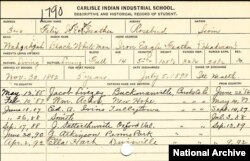Lynn Eagle Feather of Denver, Colorado, is the great-great-granddaughter of Felix Eagle Feather, a member of the Sicangu Oyate (“Burnt Thigh”) Lakota tribe who, in 1882, at the age of 17, was sent to the Carlisle Indian Industrial School in Pennsylvania, about 1,400 miles away.
Many of his descendants, including Lynn and her children, also attended boarding schools. This is Lynn’s story, in her own words:
We didn’t have a home. I was born in Rosebud, if you want to call that my home.
My mother abandoned us at the Saint Francis Mission School in Mission, South Dakota, in the early 1960s. I was about 6. My sister Janice was about 14 months younger than me.
My mother didn’t tell us what she was doing. I saw her filling out the papers and then, all of a sudden, she was gone.
I remember being scared.
We just huddled on the playground because we didn’t know anybody and they were kind of mean to us.
They’d put us out there on the playground in the dark, at night. We had bathrooms inside, but when we were outside playing at night, we had to use the outhouse. And we would be scared to go into the outhouse, 'cause the older girls told us there were ghosts in there.
We had to wear uniforms. We were woken up at the crack of dawn (before the sun came up) by a nun with a huge bell. She would walk up and down the aisles between the beds with this huge bell to wake us up. I mean, we weren’t used to that. We’re coming from the reservation. They don’t have bells on the reservation, unless they are their feet dancing.
In the mornings, I remember brushing our teeth. We would all have to brush our teeth, then go to Mass first before we could eat. Every morning.
I remember the food was nasty. The only good thing was the nuns would make buns for our afternoon snack. Some of the girls were lucky enough to have parents or family members who would give them peanut butter or jelly to put on their buns. But me and my sister didn’t have anybody. So, we would sit and eat our buns without anything on them.
I had a spinal tap done at the school because I was having headaches. I was really sick with a very high fever. I couldn’t even walk. I remember collapsing, and the priest picking me up and carrying me into the emergency room.
And after I got out of the hospital, I didn’t have my homework done, so the teacher, a nun, hit me hit me on the head with a pair of silver-handled scissors, multiple times. And that was the first time I had ever been hit by anyone in my life.
I was there for a total of maybe four months until they found us a foster home. They kept my sister and I together. The home was horrible.
Later, me and my two younger sisters were forced to go out – they would give us big hats to put on, and we would pick the potato buds off the potato plants. We would pull weeds and hoe. And all the while, my white foster sister would be sitting inside, eating a bowl of ice cream, watching us work out in the fields.
I was sent to live with about eight different families altogether. We all were sexually abused from about age 3 or 4. My sister was raped at the age of 8.
When the molestation started, we complained to the head policewoman in Lincoln, Nebraska, but she did nothing.
They found me years later. They said they caught the abuser abusing someone else and they wanted me to come back and testify against him. And I told them, if you had listened to me and my sisters, that would not have happened to that little girl. He eventually went to prison.
I ran away from foster home when I was 15 and I’ve been on my own ever since. Don’t ask me how I did it. If I had to do it nowadays, I don’t think I could.
I didn’t have any children 'til I was 18. I am so grateful that the good Lord didn’t let me get pregnant when I was still young, because that would have changed everything.
I was abused for years, most of my life. That’s why I didn’t ever get married. I chose to be on my own.
When I did have children, I didn’t know how to raise them. I lost my children to the Department of Human Services. I made sure they went to boarding school in Anadarko, Oklahoma. I chose for them to be in boarding school rather than foster care.
They made friends that they are still friends with. They liked it. They had Native teachers who weren’t abusive like the nuns were at St. Francis. My kids were never hit, molested, raped, bullied or anything. They were glad they went there.
NOTE: Lynn's son, Paul Castaway, was shot and killed by police in Denver, Col., in July 2015, as VOA reported earlier.
The St. Francis Mission School was part of a Roman Catholic mission complex on the Rosebud Indian Reservation in St. Francis, South Dakota, founded in 1886 by Jesuit priests. In the 1970s, it was renamed the St. Francis Indian School, and the Jesuits transferred control of the school to Lakota parents and other tribe members, who incorporated as a nonprofit called Sicangu Oyate Ho. Today, the St. Francis Indian School is chartered by the Rosebud Sioux Tribe. Most of the school's annual budget comes from the Bureau of Indian Affairs.







